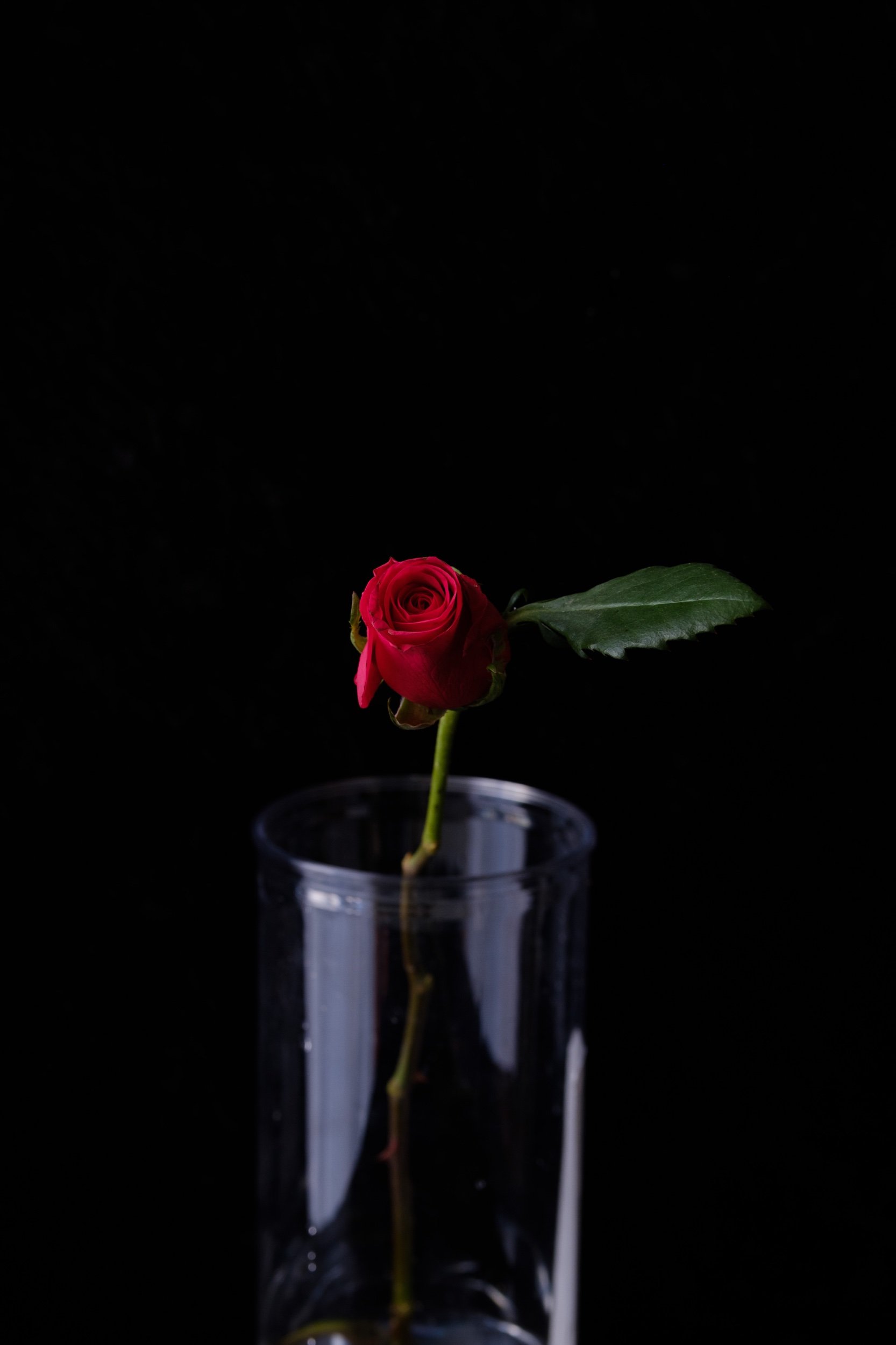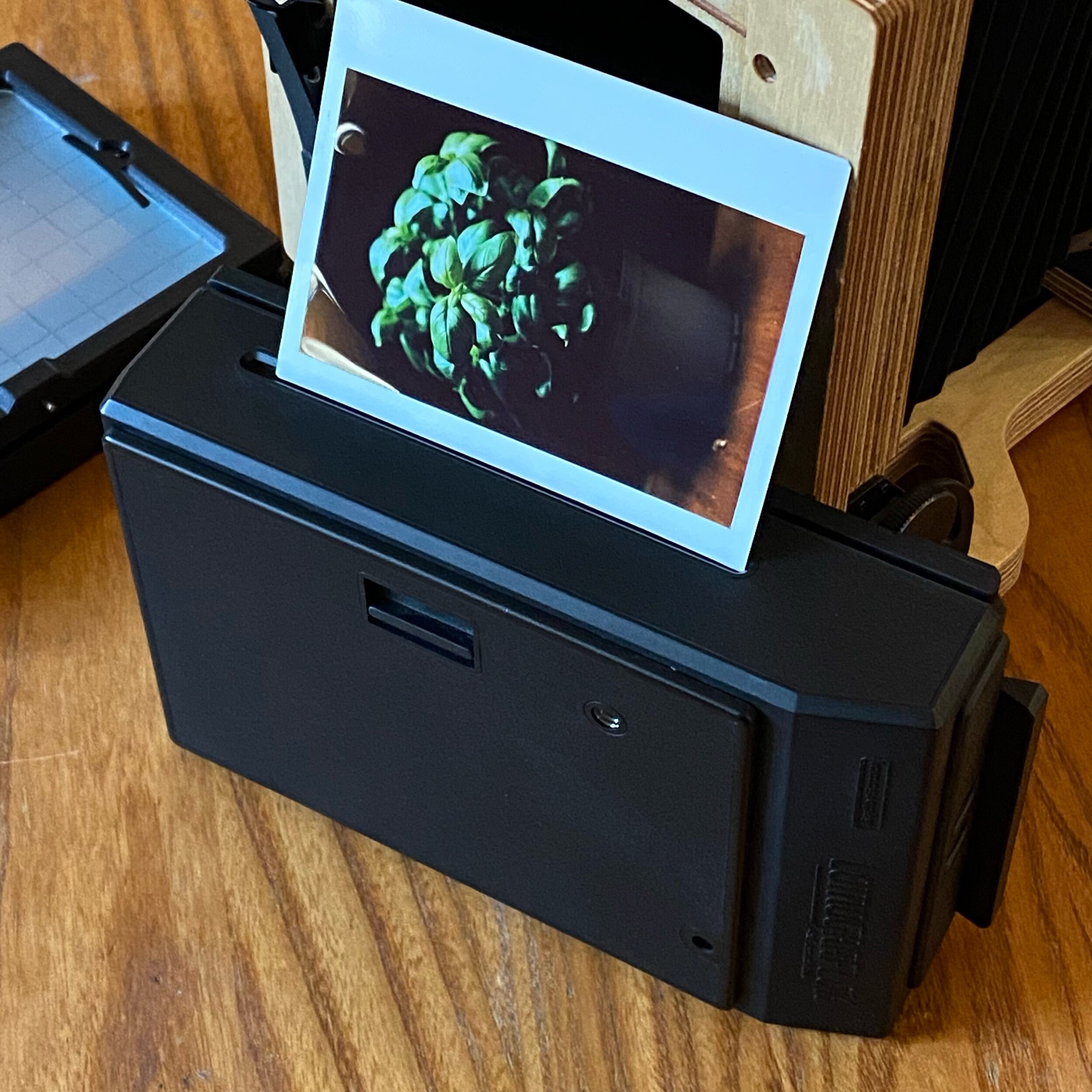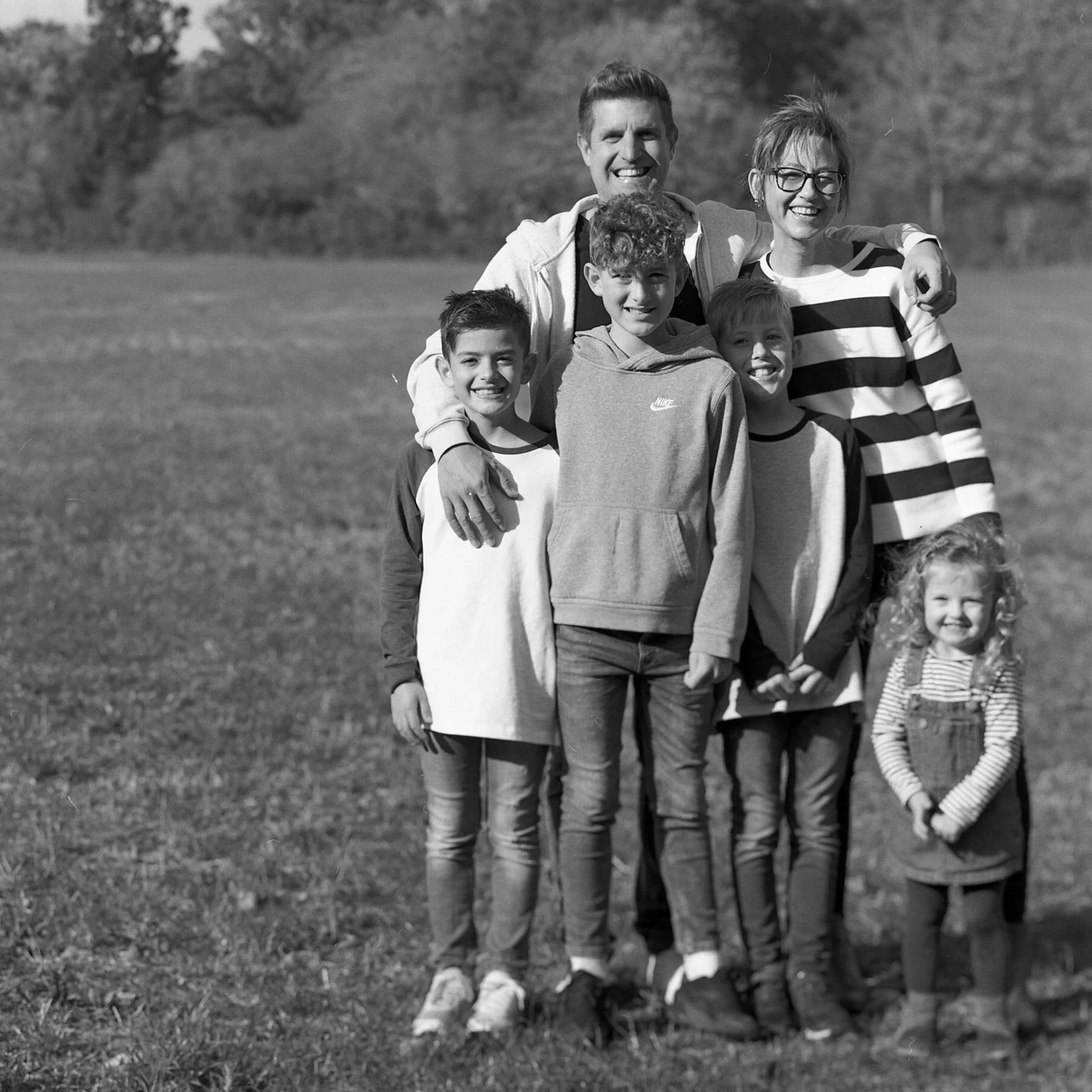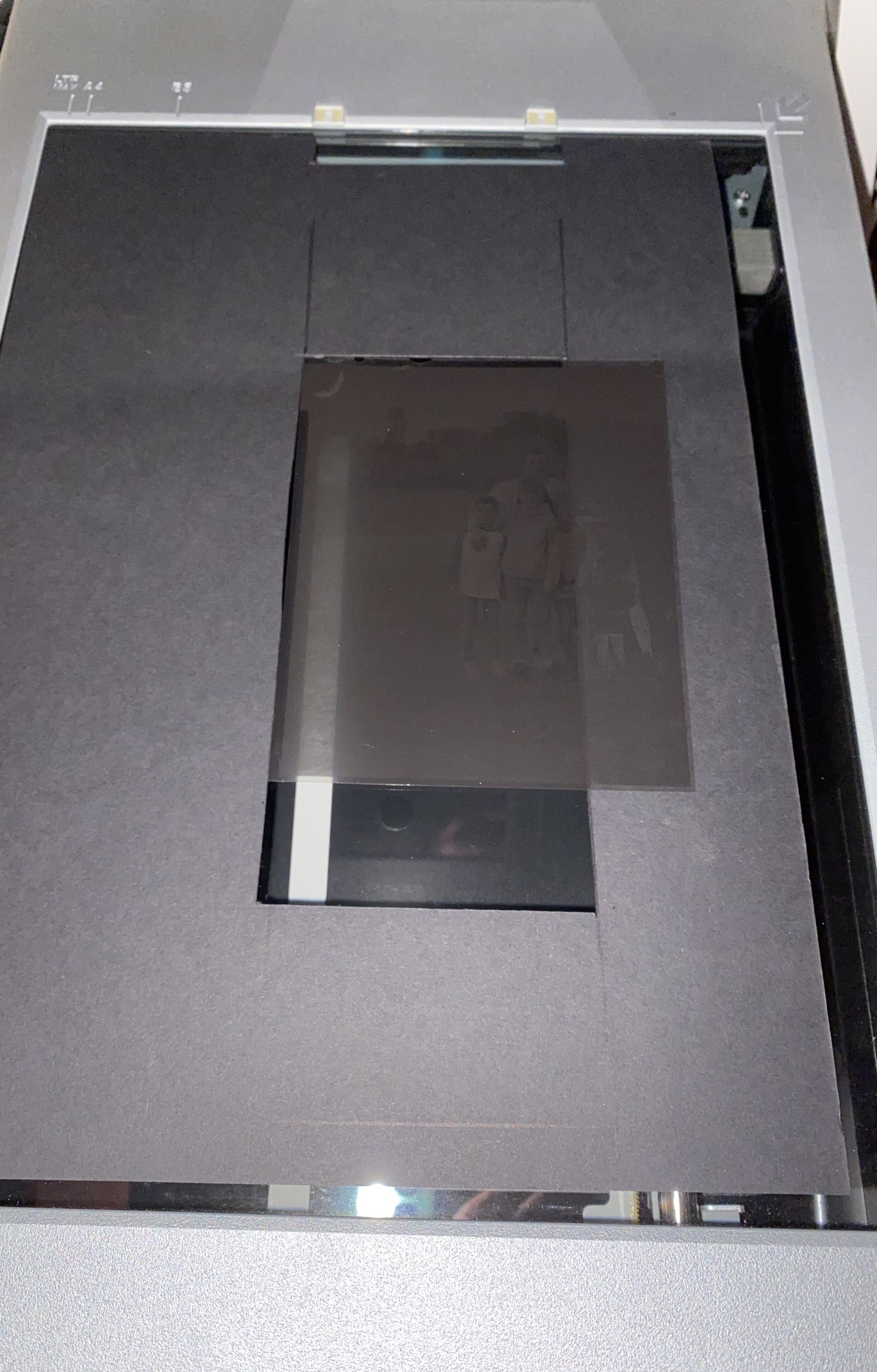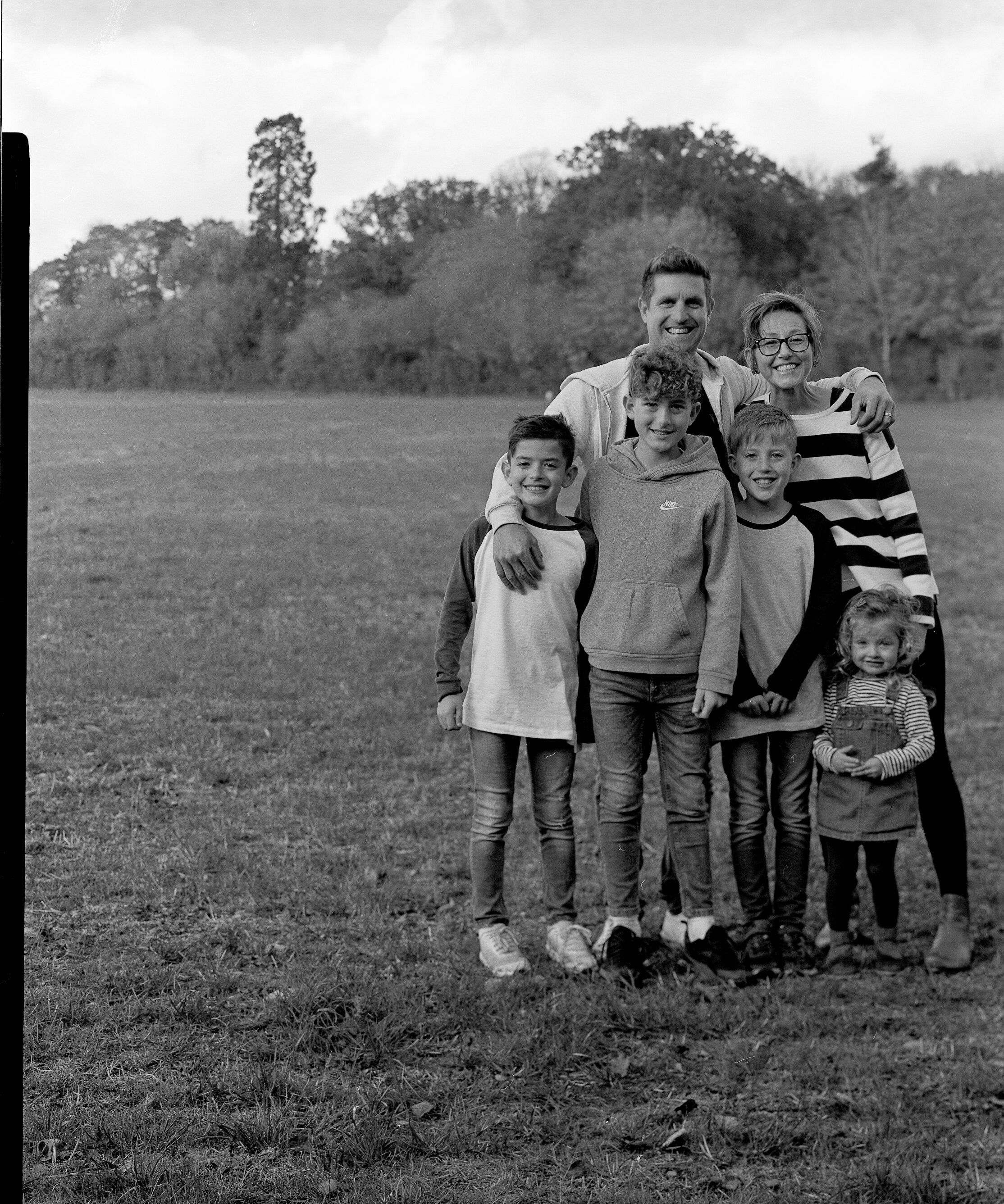Your Custom Text Here
Instant Large Format Flower Studies
It’s that quiet time of year just after Christmas when not much is going on and the light is only around for short parts of the day. So it seemed like a good time to break out the Intrepid Large Format camera and spend some quality time with a bunch of flowers.
As you can see from the following photos , the setup was very simple with just my trusty black velvet offcut draped over a clothes horse and table in front of a bright window. The Intrepid sat on my old and very solid Manfrotto tripod and I used a blanket to cover my head (as my velvet offcut was in use for the background!). And yes, you do need to hide under a cloth to focus the image on the rear ground glass of the camera - the picture is faint and barely visble in sunlight. The third image shows the view you get on the back of the camera - it’s inverted and upside down - you can imagine how hard that makes it to compose your image.
The following three images are some of the Instax Wide instant film images I took with the Intrepid and the LomoGraflok instant back. I hope that you can see that the pictures have a slightly dreamy quality and although the instant film can’t catch anywhere near the sharpness you can get from the camera with transparent film, the pictures have something about them that makes the process worthwhile. Also, they’re a unique ‘thing’ you can hold and look at within a few minutes of taking the picture, which is something special in the days of digital!
The final three images are digital photos taken in the same session, which I’ve processed in Lightroom. Whether these are ‘better’ or just differnet is really up to the viewer!
Instant Large Format Photography
What seems a very long time ago, I spotted a curious little thing that Lomo were offering that would fit on the back of our Intrepid Large Format Camera: a Polaroid style back for instant film!
I thought it might be fun to be able to get instant results from photoshoots, so joined the kickstarter and waited.
Then the pandemic hit, so I waited some more!
Finally, just recently we received a package containing a nondescript black plastic box, shown here attached to the camera:
The process of taking a photo is even more of a faff than the film process we’ve documented previously on this blog! Once you have the camera set up and focussed, you place the back on the camera and then take the photo.
You then have to remove the back (I think this is an Intrepid thing - if you leave it on the back, the clip you can see in the picture scratches the photo as it ejects) and press the button to eject the photo:
We tried this out on a recent maternity shoot and it’s great fun and helped get us all in to the right mood for the digital shots. It’s really lovely to all gather round and watch the picture appear as if by magic.
The pictures you get from this system can be very charming, but they are nowhere near the quality you can get from film in this camera or from our Fuji digital kit, but they are a unique instant memento and have a very different look to them. We’ll definitely be using it lots in the future.
Scanning Large Format Negatives
A new scan of one of our earlier shoots
A big part of creating analogue images is producing a final usable result.
When working with large format, this is further complicated because the equipment for mechanically enlarging the negatives is harder to find, more expensive, and harder to accommodate.
We’ve been looking into doing contact prints, which would give us a physical copy made entirely using the old methods, but this would be limited to prints of 4x5 inch size.
So, we also need to scan the negatives so that we can print them digitally. Our first attempts at this process involved using a flat-bed scanner and then reversing them in software to produce a positive image.
We thought the results were passable, but blamed our analogue process for the quality of the results:
Initial attempts at scanning were less than perfect!
Although this method captured the essence of the old process, it really doesn’t reflect the quality that is possible from a large format camera.
So…we kept looking.
Our scanner can scan 35mm negatives as well as medium format, but there’s no option for large format…but photoshop can stitch images together, so we thought we’d try that.
The mask is just a big piece of black card, roughly cut to shape
And it works!
I had to make a mask to put on the glass of the scanner, and we have to move the negative twice for each scan then feed the two images into photoshop.
The results are night and day between the two methods (the new scans are shown after the old ones):
Large Format Photography
Lockdown has given us some time to perfect our large format photography process - we were able to shoot a few during our most recent wedding, and we’ve shot some portraiture at home using each other as subjects.
Woz, shot by Em.
We’re using the Intrepid 4x5 as shown in previous posts and using sheet film, in this case Ilford HP5.
The film has changed what we can photograph. Previously working with paper negatives meant we needed so much light, and such long exposures that the process wasn’t really practical, especially in winter.
The film allows us to even take pictures indoors with windowlight.
Pictured with the film is the processing system we’re using - an SP-445 from stearmanpress.com
This is what’s enabled us to shoot film - as film is far more sensitive to light, it’s much harder to process in a darkened room as even a tiny amount would fog the image.
This is what it looks like with the lid off:
It’s essentially a light proof bottle that allows you to pour and mix the chemicals in daylight, meaning that you don’t need a darkroom to process the negatives.
That said, it’s still a long process, needing a sink and lots of different bottles. Calling it a processing system makes it sound a lot more automatic than it is!
Woz, shot by Em.
This and the above portrait were both shot in window light, with a single reflector being used to create some fill. Without this, one side of my face would be in very dark shadow. The reflector was hung from a light fitting in the kitchen! Not exactly a studio, but it does show that we could do this anywhere where there’s enough light.
Even in my little cottage with small windows, the exposure times aren’t too bad - these were at 1/15s, which means we won’t be shooting any indoor sports or even vague movement!
I’ll write in another post about the trials and tribulations of actually using large format in a wedding situation, which offers many more challenges!
Intrepid Camera family shoot
We had a family shoot towards the end of October and as we were preparing to finish we asked if they would be happy to pose long enough for us to try out our Intrepid large format camera. They were very keen! When the camera emerged from the car they were all extremely curious and wanted to get under the dark cloth and have a look at the screen to see what we saw.
The image you get on the back, as you’re focussing the camera, is upside down and reversed, which makes framing the image quite interesting!
When you add that you can’t just ‘click a button’ and get a picture, the whole thing becomes much more of an event than using a digital camera.
Here’s the rough process, to give you an idea of the time it all takes:
Arrange everyone in the frame. There’s no zoom and everything is cumbersome and on a tripod, so this involves moving people and camera around a lot…which you’ll see we didn’t quite get right!
Get under the dark cloth and focus the image.
Get a meter reading (we cheated and used one of our Fuji cameras)
Set the Aperture and shutter speed.
Realise people have moved, so refocus the image.
Notice a cloud has covered the sun, so take another meter reading and change the settings!
Manually cock the shutter - this is priming a spring that will open and close the shutter for a set time when you eventually get to press it!
Close the shutter - you have to do this manually and if you forget you will expose the film when you remove the dark slide at step 10 and get no picture.
Insert the film holder (you can’t do this before as it goes in front of the focussing screen and blocks your view).
Remove the dark slide.
Get everyone to smile…while noticing the cloud has moved so the light has changed!
Press the shutter button.
Replace the dark slide.
Remove the film holder.
This process happens for each shot, and takes a while! Weirdly though, it’s such a performance that the family posed really well and it’s about the only time we got them all to hold still and smile at the same time!
Of course, we had no idea if we’d managed to actually capture anything on our 4 shots, so off we went to process the film.
Result!
Of the four shots, we got one dud, which we think was because the shutter was cocked but not closed, and two that are a bit too contrasty because the light changed before we took the picture.
Overall though, we’re happy with the results on this first trial. Next time, we’ll definitely spend more time posing and hopefully less time in the process of taking the image!
Fuji!
For a long time now, we've been using a range of cameras from a couple of camera systems for our wedding photography - we have used the canon 5DIII, the canon 7D and a pair of Olympus OMDs. We've got quite an extensive range of lenses for both systems...we used the same collection of kit for our event and gig photography too
At the end of last year, we decided that in order to make our workflow a little easier we'd move to a single manufacturer and have matching cameras. Well, it's not quite worked out like that, as I'm very attached to my OMDs and Em still loves her very well worn canon.
But, we do have a pair of spanking new Fujifilm X-H1s that are now our main bodies for all our weddings.
We picked Fuji because their cameras create beautiful images in both colour and mono, while having an extremely well designed interface with all the settings you need immediately available on the camera. It's great to see all the settings immediately without having to delve through menus.
It helps that the cameras are very handsome to look at and have a classic analogue look to them.
We're also very impressed with their lens line-up, which caters to professionals with their xf range, and the set we have are the XF WR R - Fuji love their letters!
The XF range are their premium lenses, the WR stands for water resistant and the R means that the lens has an aperture ring on it. When the lenses are on our X-H1 cameras, you can actually run them under a tap! We've not tried this...
We've been using the system a couple of months now and we're very impressed. We're especially impressed with the quality of the images we're getting.
Things we love about them:
They are quiet. We didn’t realise just how quiet until we shot a wedding with them this month. I’ve previously favoured my Olympus kit during the ceremony as they are much quieter than a traditional SLR but the X-H1 has been designed with a damped shutter mechanism that makes them almost completely unobtrusive while still having a satisfying noise that tells you you’ve taken a picture.
They can shoot in very low light. We shoot in a documentary style, sometimes resorting to flash for the dancing, to add a little excitement to the images.
They’re pretty!
This shot of Frank Turner was taken at the cavern in Exeter last week. The venue is very small with a capacity of about 200, it was dark and crowded with hot spots in the lighting.
We are currently processing the shots from our latest wedding and will post samples when we can.







